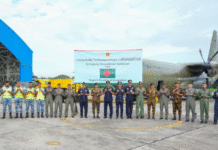
The water was once so clear that you could see the bottom of the Turag canal. Locals would even drink from it.
Now what one would find there is black liquid, and it smells so bad that it is hard even to stand beside it, said Tara Mia, an elderly from Barabari village along the canal.
“We used to catch fish in this canal and also the Chankirtek Beel nearby. But now you won’t even get a frog in this water,” he added.
“Since industries sprang up in the area, the colour of the water changed and our sufferings began,” said the 70-year-old, sitting in a tea stall.
Two more locals — Shamim Hossain and Masudul Billal — joined in with their observations.
Sometimes, they said, the stench wafting from the banks of the Turag canal flowing through Shukundirbag village, is suffocating.
“Now we are habituated to this. But if relatives come, they cannot take the stench as well as the mosquitoes — there are lots of them,” said Shamim, a youth from Hyderabad village.
In a visit to Tongi in Gazipur this month, this correspondent observed that garments washing plants and textile units in Gazipura area and industries located in Bangladesh Small and Cottage Industries Corporation (BSCIC) area are discharging liquid waste into streams, canals and other waterbodies.
The untreated liquid waste from the industries, as well as sewage from Tongi municipality area stream into the Turag river through the canal, also named Turag, affecting people’s lives and livelihoods.
People from Gazipura, Barabari, Kunia, Baghailkur, Shukundi, Nimtali, Ershadnagar, Banamai, Duttapara, Harbait, Baigertek, Hyderabad and Mazukhan are suffering due to this pollution.
Starting from Gazipura village, the canal is bringing polluted water through the Barachak Beel and down to the Turag river near the Majukhan bridge in the Nimtali area. All these villages are located on the banks of the canal.
Many villagers own property but cannot sell, they claim, as the land is surrounded by putrid waterbodies. Villagers who have land in the Chankirtek Beel do not want to cultivate it as their crops get affected by the pollution.
“Every year, I cultivate paddy on my land. But the production has declined so much, I cannot recover expenses most of the time. Initially, the crop was good. But ultimately, there is no paddy on the sheaves,” said Asad Mia, from Haji Bari of Shukundi village, who inherited around two acres of land by the Turag river.
As the land has almost no use for him, Asad wanted to sell it. “But the value of the land has decreased due to this pollution. People offer almost half price,” he said.
According to locals, it all started nearly 20 years ago. Over the years, they have seen several drives on the polluting factories, conducted by the Department of Environment.
But the pollution never stopped.

Contacted, Abdus Salam, assistant director at the Department of Environment’s Gazipur office, said there are around 6,500 industrial units in the district, of which only 490 units discharge liquid waste. And 455 of these have installed effluent treatment plants (ETP).
He added that 12 washing plants in Gazipura area have not installed ETPs yet.
The authorities still have to regularly conduct drives against industrial units who have ETPs, because owners do not want to run these frequently.
“Whenever they get a chance, they discharge untreated waste into the waterbody,” said Abdus Salam.
“It is not possible for us to guard them 24 hours a day. But whenever we get any complaints about pollution, we investigate and conduct drives against those units,” he added.
Rivers and other waterbodies around Dhaka city started getting polluted since the garment manufacturing units started mushrooming in and around it.
Under the Environment Conservation Act, 1995 (amended in 2010), textile dyeing factories are categorised as “red” industries and are legally bound to install and run ETPs.
Prof Mohidus Samad Khan, who teaches at the chemical engineering department of Buet, is currently studying the effects of pollution by textile industries in Dhaka.
His research reveals textile factories use, on average, 120 litres of water to dye and wash a km of fabric (about two pairs of jeans). Many subsequently discharge the effluent into nearby rivers or wetlands without proper treatment.
Though most of the factories have installed ETPs, many of these ETPs are undersized.
“Once they expand their factories after constructing the ETP, they cannot expand the size of the ETP. So, the ETP becomes undersized and it cannot treat the extra volume of waste water,” he said.
When asked about initiatives to stop pollution by readymade garments factories, Rubana Haq, president of Bangladesh Garments Manufacturers and Exporters Association (BGMEA) said most garments manufacturers do not have their own washing plants.
“So, most of these polluters are not garments manufacturers. But these violations have to be stopped. If we get details, names and addresses of the factories and the owners involved, we will take necessary steps,” she said.









